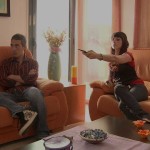¿Qué ves?
Sandro goes to Eva’s consultancy to take a personality test.
In this episode you will learn: how to express impatience, sarcasm and show your temper.
VA: Por fin te has atrevido a venir a mi consulta.
SANDRO: Es para hacerte feliz.
EVA: Yo creo que has tardado tanto porque me tienes miedo.
SANDRO: Bueno, ¿qué?, ¿vas a empezar con el dichoso test? ¡o me voy!
EVA: Vale, vale, macho ibérico, tranquilo.
Te presento el Test de Rorschach, conocido popularmente como el de las manchas.
Gracias a él, podré descubrir rasgos básicos de tu personalidad.
SANDRO: Vale, pero empezamos.
EVA: Allá voy. ¿Qué ves?
SANDRO: Una Mariposa.
EVA: ¿Y ahora?
SANDRO: Un elefante.
EVA: ¿Y esto?
SANDRO: Una mujer.
SANDRO: Una mujer en bikini.
EVA: ¡¡¡Sandro!!!
SANDRO: Ahora veo una chica haciendo topless. ¡Anda! ¡Si eres tú!
EVA: ¡Oye! Un poco de respeto, ¡esto no es un juego!
SANDRO: Yo sólo digo lo que veo. Mira, ahora estás haciendo topless, con un Mojito en la mano en el IbizaClub.
EVA: ¿Cómo? ¡ostras!, las fotos de mis últimas vacaciones.
SANDRO: Yo te estaba avisando.
EVA: At last you’ve dared to come to my office.
SANDRO: It’s to make you happy.
EVA: I think it’s taken you so long because you are scared of me.
SANDRO: Well, what?, Are you going to start with the bloody test? or I leave!
EVA: Ok, ok, macho man, quiet. I introduce you to the Rorschach Test, popularly known as the stain.
Thanks to it, I will be able to discover some basic characteristics of your personality.
SANDRO: Okay, but let’s start.
EVA: Here I go.What do you see?
SANDRO: A butterfly.
EVA: And now?
SANDRO: An elephant.
EVA: What about this?
SANDRO: A woman.
SANDRO: A woman in bikini.
EVA: Sandro!
SANDRO: Now I see a girl in topless. Wow! It’s you!
EVA: Hey! Some respect, this is not a game!
SANDRO: I only say what I see. Look, now you’re doing topless, with a Mojito in hand at IbizaClub.
EVA: How? Shit! the photos of my last holiday.
SANDRO:I was warning you.
Por fin has llegado.
You finally arrived.
We use it when we have been waiting for something and it finally comes.
Es para hacerte feliz.
It’s to make you happy.
We have two prepositions in Spanish quite difficult, those are POR and PARA. We can simply say that POR is used to show the cause while PARA is used to show the finality of something. Examples: Estudio español para viajar por Sudamérica. I study to travel.
No he podido llegar pronto porque he perdido el autobús.
I couldn’t arrive sooner because I missed the bus.
PORQUE is a word we use to express cause, usually it answers the question WHY? Example: ¿Por qué cierras la ventana? Porque tengo frío. Why do you close the window? Because I’m cold.
Creo que podré reservar el vuelo mañana.
I think I will be able to book the flight tomorrow.
PODRÉ is the future form of PODER. It’s an irregular verb which root is POD and the endings are: É, ÁS, Á, EMOS, ÉIS, ÁN. Similar to this verb is TENER (tendré), PONER (pondré), SABER (sabré), CABER (cabré), VENIR (vendré).
Estaba avisándote de estos problemas.
I was warning you about these problems.
ESTAR + GERUNDIO. We use this form to express a long action in the past. We use the Imperfect tense of ESTAR: estaba, estabas, estaba, estábamos, estábais, estaban. Plus a gerund which is form with the infinitive + ANDO or IENDO. Example: Comer — comiendo, Salir– saliendo, Hablar– hablando


